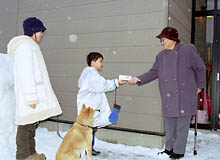YEN RIVALS:
The Rising Popularity of Local Currencies
January 15, 2001
|
 |
|
A boy receive "Kurin" in return for walking a woman's dog. (Kuriyama Ecomoney Study Group)
|
A growing number of communities across Japan are issuing their own currencies with the aim of giving value to hard-to-price services, such as companionship, shopping, moving assistance, and even information, and encouraging their exchange among local residents. Like yen, these currencies can be traded and saved, though they accrue no interest. The programs now taking shape are modeled on what is known as the "local exchange and trading system," a scheme to reduce unemployment that gained popularity in Europe and the United States in the latter half of the 1980s. Local currencies, many believe, hold the key to fostering volunteer activities and revitalizing communities.
Give-and-Take Among Community Members
In Japan local currencies are usually referred to as "ecomoney," a name that brings together the concepts of ecology, economy, and community. In September 2000 about 30 local government officials and others interested in issuing local currencies gathered in Tokyo to attend a seminar on ecomoney. The instructor of the course was a representative of the Kuriyama Ecomoney Study Group, which recently carried out a pilot program in the town of Kuriyama in Hokkaido. The group was formed in September 1999 after a number of people in town got together with the aim of launching a local currency in order to offer welfare activities not covered by the Long-Term Care Insurance system, such as companionship for elderly people.
The town of Kuriyama has a population of 15,000 and is located about 50 kilometers (31 miles) east of Sapporo. About 550 people took part in the program, which ran from September to November 2000. Participants initially registered the services they wanted to give and receive and were given 5,000 kurin--the name given to the local currency--in start up money. On the basis of this a directory of 5,500 types of services, such as shopping, child-care consultations, and snow clearing, was compiled and distributed to each person.
Three denominations of the local currency were printed: 1,000 kurin, 500 kurin, and 100 kurin. The suggested value of services was set at 1,000 kurin for 60 minutes. One older woman, for example, received 1,000 kurin for showing a younger woman how to pickle vegetables. At the end of a transaction, the name of the recipient or service provider, type of service received or given, date, value of the service, and outstanding balance of kurin were recorded in the accounts of the two parties. Many older men and women used the kurin they amassed to get help shoveling and clearing snow.
The local currency programs in other communities, though similar to the Kuriyama setup, reflect local conditions and needs and diverge in a number of ways. The "oumi" currency launched in April 1999 in the town of Kusatsu in Shiga Prefecture is one example. One oumi is equivalent to 100 yen (0.91 U.S. dollars at 110 yen to the dollar). Participants initially pay a registration fee of 1,000 yen (9.1 dollars) and receive 8 oumi from the secretariat. They then barter services using a list that encompasses 140 activities, such as companionship for older people and shopping. The amount to be paid is either set in advance or decided on by the people giving and receiving a service.
An Impetus for New Welfare Programs and Closer Communities
Local currencies have proliferated over the past few years. The number of communities that have issued or are planning to issue their own currencies now stands at 30 and is expected to climb to 50 by the end of 2000, according to an ecomoney liaison organization.
Some programs aim not only to promote closer community ties and recycling but also revitalize local economies. One shopping district in the city of Kochi in Shikoku, for example, is now drawing up a plan to lure more customers by offering them a local currency called "enbasa." Under the plan enbasa are given for such services as cleaning up parking lots and handing out fliers, and people amassing 100 enbasa can receive a 10% discount on goods.
Though local currency programs take a variety of shapes, the idea behind them remains the same; an exchange of goodwill that cannot be measured in yen. Local currencies may hold the key to creating innovative welfare plans for the elderly, community building, and the revitalization of local economies.
 Copyright (c) 2001 Japan Information Network. Edited by Japan Echo Inc. based on domestic Japanese news sources. Articles presented here are offered for reference purposes and do not necessarily represent the policy or views of the Japanese Government. Copyright (c) 2001 Japan Information Network. Edited by Japan Echo Inc. based on domestic Japanese news sources. Articles presented here are offered for reference purposes and do not necessarily represent the policy or views of the Japanese Government.
|



















